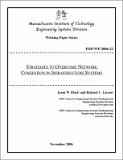| dc.description.abstract | Networked Infrastructure systems deliver services and/or products from point to point along the network. They include transportation networks (e.g., rails, highways, airports, sea ports), telecommunication networks (by frequency-bounded airwaves or cables), and utilities (e.g., electric power, water, gas, oil, sewage). Each is a fixed capacity system having marked time-of-day and day-of-week patterns of demand. Usually, the statistics of demand, including hourly patterns (i.e., means and variances) are well known and often correlated with outside factors such as weather (short term) and the general economy (longer term). | en_US |
